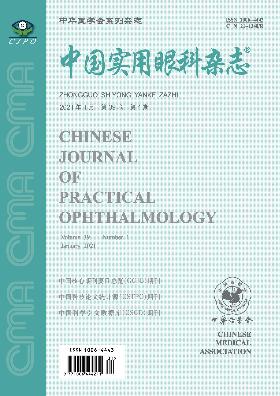Clinical correlation research of serum retinol binding protein 4 and type 2 diabetic retinopathy
引用次数: 0
Abstract
Objective To explore the relationship of serum retinol binding protein 4 (RBP4) with type 2 diabetic retinopathy. Methods Clinical case control study. The 83 cases of hospitalized pa-tients with type 2 diabetes mellitus (T2DM) were divided into three groups: PDR group (n =32 fun-dus examination showed proliferative diabetic retinopathy), NPDR group (n =20 fundus examination showed non proliferative diabetic retinopathy), NDR group (n =31 fundus examination showed nor-mal). Their serum RBP4 levels were measured. At the same time, factors that may be closely relat-ed to the occurrence and development of DR were detected. And we also measured the amplitude of B wave in full field electroretinogram (F-ERG). Results Serum RBP4 differences among three groups had statistical significance, P <0.05; There was significant difference in B wave amplitude among the three groups, P <0.05. Simple correlation analysis showed that the serum RBP4 level was negatively correlated with the b wave amplitude of ERG (r =-0.458, P =0.0001). Binary Logistic regres-sion analysis showed that RBP4 was significantly correlated with DR (B =0.105, P =0.019). Conclusions The increase of serum RBP4 level is consistent with the progress of DR. There is a close rela-tionship between serum RBP4 and the damage of retinal bipolar cells. Key words: Type 2 diabetes mellitus; Diabetic retinopathy; Retinol binding protein 4; Full-Field Electroretinograms血清视黄醇结合蛋白4与2型糖尿病视网膜病变的临床相关性研究
目的探讨血清视黄醇结合蛋白4 (RBP4)与2型糖尿病视网膜病变的关系。方法临床病例对照研究。将83例住院2型糖尿病(T2DM)患者分为3组:PDR组(32例眼底检查显示增殖性糖尿病视网膜病变)、NPDR组(20例眼底检查显示非增殖性糖尿病视网膜病变)、NDR组(31例眼底检查正常)。测定血清RBP4水平。同时,检测可能与DR发生发展密切相关的因素。并在全视场视网膜电图(F-ERG)中测量B波振幅。结果三组间血清RBP4差异有统计学意义,P <0.05;三组患者B波振幅差异有统计学意义,P <0.05。简单相关分析显示,血清RBP4水平与ERG b波振幅呈负相关(r =-0.458, P =0.0001)。二元Logistic回归分析显示RBP4与DR显著相关(B =0.105, P =0.019)。结论血清RBP4水平的升高与dr的进展一致,血清RBP4与视网膜双极细胞损伤有密切关系。关键词:2型糖尿病;糖尿病视网膜病变;视黄醇结合蛋白4;细致的视网膜电流图
本文章由计算机程序翻译,如有差异,请以英文原文为准。
求助全文
约1分钟内获得全文
求助全文
来源期刊
自引率
0.00%
发文量
9101
期刊介绍:
China Practical Ophthalmology was founded in May 1983. It is supervised by the National Health Commission of the People's Republic of China, sponsored by the Chinese Medical Association and China Medical University, and publicly distributed at home and abroad. It is a national-level excellent core academic journal of comprehensive ophthalmology and a series of journals of the Chinese Medical Association.
China Practical Ophthalmology aims to guide and improve the theoretical level and actual clinical diagnosis and treatment ability of frontline ophthalmologists in my country. It is characterized by close integration with clinical practice, and timely publishes academic articles and scientific research results with high practical value to clinicians, so that readers can understand and use them, improve the theoretical level and diagnosis and treatment ability of ophthalmologists, help and support their innovative development, and is deeply welcomed and loved by ophthalmologists and readers.

 求助内容:
求助内容: 应助结果提醒方式:
应助结果提醒方式:


